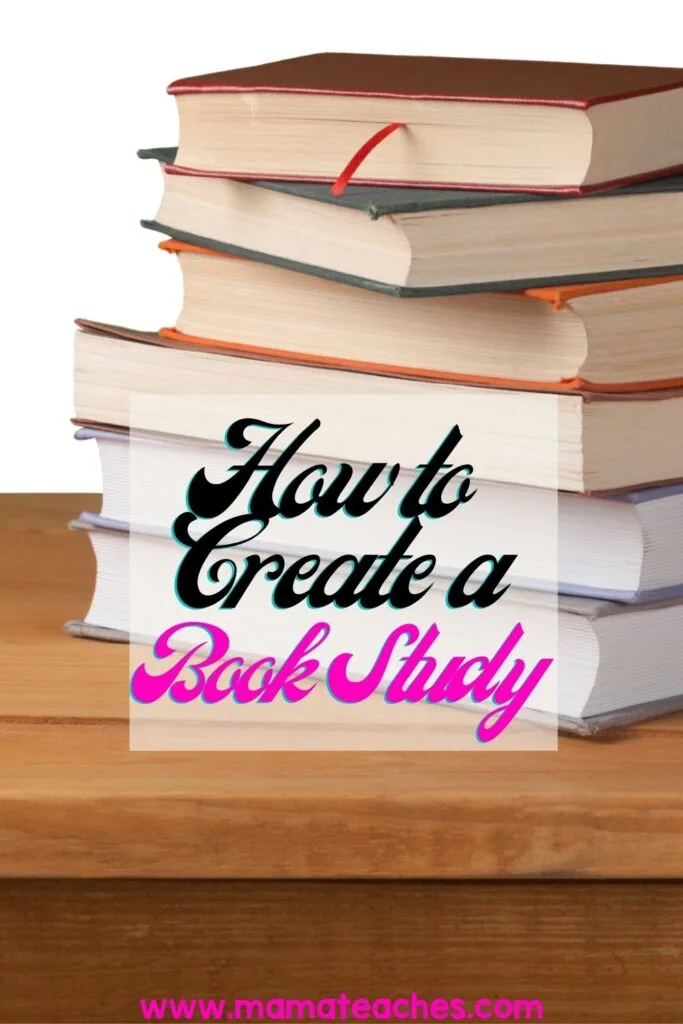Reading doesn’t have to be a strictly solitary activity.
Discuss the big ideas, share experiences, and develop comprehension with a book study.
Then sit back and watch your kids’ love of reading soar!

This article contains affiliate links to things that you might like.
What Is a Book Study?
A book study is centered around the discussion.
It is not a chance for you, the teacher, to teach the book.
It is collaborative and conversational.
All you need to hold a book study is a book and a small group (yes, two people can have a book study together!).
A book study can be a one-time event (when you discuss a completed book) or an ongoing occurrence (when you discuss a book by chapters).
Why You Should Use a Book Study
Reading begins as a skill subject, much like math.
It takes frequent and consistent instruction for a child to decode symbols to sounds to meaning.
Learning the skill of reading is hardly a labor of love.
Reading turns a corner when a student discovers the beauty of language, the intrigue of a well-told story, and the delight in learning new information.
When you can share those discoveries with others, your enjoyment of reading increases tenfold.
A book study is key to building community, connection, and joy around reading.
A book study has even more educational benefits. Discussion questions can reveal a student’s reading comprehension.
Talking about a scene from a book gives the student a chance to practice summarizing.
When a student participates in a book study, he practices intellectual conversation and gives voice to his ideas; these are also skills that transcend a simple reading assignment.

How to Create a Book Study
Book studies are simple to implement if you follow these steps:
Step 1: Set a Goal
Vision cast for a moment.
At the end of this book study, what do you want the students to be able to do?
These goals do not need to be lofty.
Here are some ideas:
- Participate in a balanced discussion (give others a chance to share)
- Respond orally to comprehension questions
- Connect reading with another subject (cross-curricular activities)
- Build connections between participants
- Generate ideas for a writing assignment
- Appreciate the elements of story craft
- Connect choices in the book to choices facing the student
- Learn about others’ perspectives and ideas
Step 2: Choose a Book
I know this seems rather obvious, but you must pick a book after you set your goals.
You also want to choose a book that draws in the readers.
Know your audience, and pick something that will excite your group.
Step 3: Read the Book and Plan It Out
How will you divide the book for discussion?
Make a timeline for what you will discuss when.
For every section, compose some reading comprehension questions and some discussion questions.
Brainstorm activities to go along with the book study (if that is something you want to do).
Step 4: Pick a Place
Where will you hold the book study?
Will it be in person or online?
Google Classroom is an awesome place to hold a virtual book study because it has so many features (like a calendar, a place for assignments, and discussion).

Step 5: Lead with Love
As the facilitator of the conversation (remember, you are not teaching!), you need to lead the group with support and encouragement.
Your manner can make or break the experience.
Lead with an open hand.
Conversations are not predictable, but it could be that the discussion wends its way to a place better than you envisioned!
Step 6: Follow Up
Plan an activity or assignment that allows the study members to share what they have learned, processed, or discovered from the book study.
A book study is a terrific springboard for creativity.
Learning how to Create a Book Study
A book study is an opportunity to make reading come alive for your students.
It could be the bridge that takes kids from reading “for school” to reading “for the fun of it.”

keisha
Saturday 12th of August 2023
Hi Brandi, It is the first time I am visiting your page and found it to be very informative and helpful. I will definitely be visiting again.